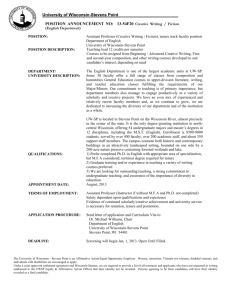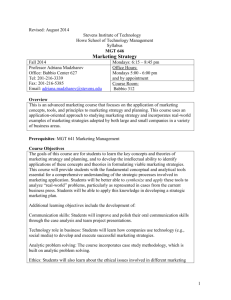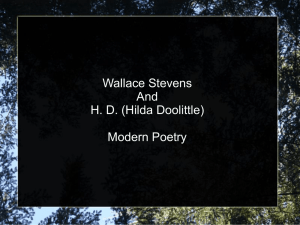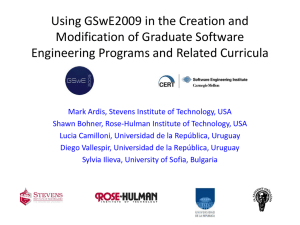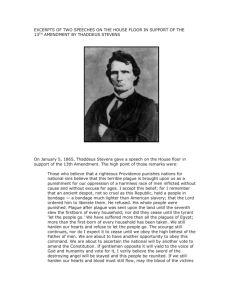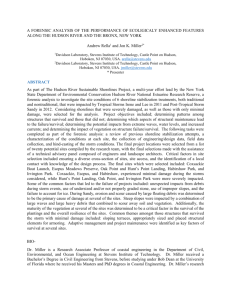Moot Court Activity - Handout - South Carolina Bar Association
advertisement
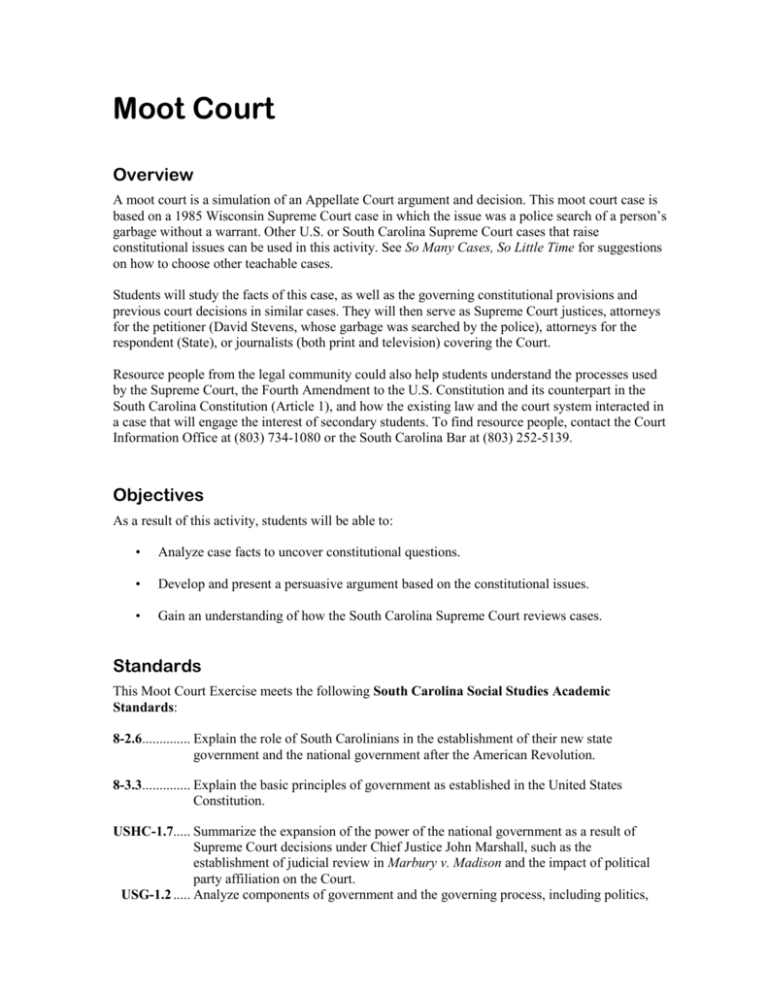
Moot Court Overview A moot court is a simulation of an Appellate Court argument and decision. This moot court case is based on a 1985 Wisconsin Supreme Court case in which the issue was a police search of a person’s garbage without a warrant. Other U.S. or South Carolina Supreme Court cases that raise constitutional issues can be used in this activity. See So Many Cases, So Little Time for suggestions on how to choose other teachable cases. Students will study the facts of this case, as well as the governing constitutional provisions and previous court decisions in similar cases. They will then serve as Supreme Court justices, attorneys for the petitioner (David Stevens, whose garbage was searched by the police), attorneys for the respondent (State), or journalists (both print and television) covering the Court. Resource people from the legal community could also help students understand the processes used by the Supreme Court, the Fourth Amendment to the U.S. Constitution and its counterpart in the South Carolina Constitution (Article 1), and how the existing law and the court system interacted in a case that will engage the interest of secondary students. To find resource people, contact the Court Information Office at (803) 734-1080 or the South Carolina Bar at (803) 252-5139. Objectives As a result of this activity, students will be able to: • Analyze case facts to uncover constitutional questions. • Develop and present a persuasive argument based on the constitutional issues. • Gain an understanding of how the South Carolina Supreme Court reviews cases. Standards This Moot Court Exercise meets the following South Carolina Social Studies Academic Standards: 8-2.6.............. Explain the role of South Carolinians in the establishment of their new state government and the national government after the American Revolution. 8-3.3.............. Explain the basic principles of government as established in the United States Constitution. USHC-1.7..... Summarize the expansion of the power of the national government as a result of Supreme Court decisions under Chief Justice John Marshall, such as the establishment of judicial review in Marbury v. Madison and the impact of political party affiliation on the Court. USG-1.2 ..... Analyze components of government and the governing process, including politics, power, authority, sovereignty, legitimacy, public institutions, efficacy, and civic life. USG-1.4 ..... Analyze the institutional and organizational structure of government that allows it to carry out its purpose and function effectively, including the branches of government and legitimate bureaucratic institutions. USG-1.5 ..... Evaluate limited government and unlimited government with regard to governance, including rule of law, the role of constitutions, civil rights, political freedom, economic freedom, and the ability of citizens to impact or influence the governing process. USG-2.1 ..... Summarize core principles of United States government, including limited government, federalism, checks and balances, separation of powers, rule of law, popular sovereignty, republicanism, individual rights, freedom, equality, and selfgovernment. USG-3.1 ..... Evaluate the Constitution as the written framework of the United States government, including expression of the core principles of limited government, federalism, checks and balances, separation of powers, rule of law, popular sovereignty, republicanism, individual rights, freedom, equality, and self-government. USG-3.4 ..... Analyze the organization and responsibilities of local and state governments in the United States federal system, including the role of state constitutions, the limitations on state governments, the typical organization of state governments, the relationship between state and local governments, and the major responsibilities of state governments. USG-4.1 ..... Evaluate the role of the citizen in the American political process, including civic responsibilities and the interaction between the citizen and government. USG-4.5 ..... Evaluate the importance of civil rights and civil liberties for citizens in American political culture and the protective role of the national government through the Bill of Rights, the judicial system, and the Fourteenth Amendment. This Moot Court Exercise meets the following South Carolina English Language Arts (ELA) Standards: Inquiry-Based Literacy ...................................................................................... Grades 6, 7, 8 English I, II, III, and IV Standard 1: Formulate relevant, self-generated questions based on interests and/or needs that can be investigated. Standard 2: Transact with texts to formulate questions, propose explanations, and consider alternative views and multiple perspectives Standard 3: Construct knowledge, applying disciplinary concepts and tools, to build deeper understanding of the world through exploration, collaboration, and analysis. Standard 4: Synthesize integrated information to share learning and/or take action. Reading Informational Text ............................................................................ Grades 6, 7, 8 English I, II, III, and IV Standard 1: Demonstrate understanding of the organization and basic features of print. Standard 2: Demonstrate understanding of spoken words, syllables, and sounds. Standard 3: Know and apply grade-level phonics and word analysis skills in decoding words. Standard 4: Read with sufficient accuracy and fluency to support comprehension. Standard 5: Determine meaning and develop logical interpretations by making predictions, inferring, drawing conclusions, analyzing, synthesizing, providing evidence, and investigating multiple interpretations. Standard 6: Summarize key details and ideas to support analysis of central ideas. Writing ............................................................................................... Grades 6, 7, 8 English I, II, III, IV Standard 1: Write arguments to support claims with clear reasons and relevant evidence. Standard 2: Write informative/explanatory texts to examine and convey complex ideas and information clearly and accurately through the effective selection, organization, and analysis of content. Standard 3: Write narratives to develop real or imagined experiences or events using effective techniques, well-chosen details, and well-structured event sequences. Standard 4: Demonstrate command of the conventions of standard English grammar and usage when writing and speaking. Communication ...................................................................................................... Grades 6, 7, 8 English I, II, III, and IV Standard 1: Interact with others to explore ideas and concepts, communicate meaning, and develop logical interpretations through collaborative conversations; build upon the ideas of others to clearly express one’s own views while respecting diverse perspectives. Standard 2: Articulate ideas, claims, and perspectives in a logical sequence using information, findings, and credible evidence from sources. Materials Materials are pages included in this pdf document. The Court of Appeals and Wisconsin Supreme Court opinions in State v. Stevens are available on the Wisconsin Supreme Court Web site at www.courts.state.wi.us Procedures The procedures used in this simulation will be slightly different than those actually used by the South Carolina Supreme Court and other Appellate Courts. The attorneys’ oral arguments to the Court will be shorter. The justices will allow attorneys to complete their formal presentations to the Court before asking questions, rather than interrupting the presentation with questions. We are sacrificing some authenticity so as to enhance the educational value of the simulation through more active participant involvement and more efficient time management. The simulation is set up as a cooperative learning activity with every participant having a role to play that will contribute to the overall success of the activity. 1. Have students, working in pairs or small groups, read and clarify the facts of the cases, answering questions like: o What happened in the case? o Who is involved? o How did the lower court rule in the case? o Who is the petitioner, the respondent? 2. Facilitate a class discussion on the issues of the case. Ask students to identify the main issues by phrasing them as questions. Focus on the constitutional questions raised by the case. 3. Select an odd number of students (five to seven) to be justices. Divide the remaining students into two teams. One team will represent the petitioner. The other team will represent the respondent. To increase student participation, several students can be selected to play the role of journalists. Give each student the handout pertaining to the role he/she is playing. 4. Conduct moot court. Note: either the teacher or a student from one of the “attorney” teams should keep time during the argument. 5. The teacher now explains how the case was actually decided by the Wisconsin Supreme Court and notes ways in which the processes used in the simulation were similar and different from those actually used by the Court. In the event the student’s decision and the Court’s are different it is helpful for the students to understand the reasoning in the dissenting opinions as well as the majority. The students are not wrong, but the majority of the real Court was influenced by different compelling arguments. Ask the students to evaluate the reasoning the Court used in the majority and dissenting opinions and compare these to their reasoning. Continue to debrief the activity by discussing what the decision means for the both sides and for society. Structure for the Moot Court • The Chief Justice officially opens the Court session and calls the case. • Attorneys for David Stevens have five minutes to present their formal arguments. The justices then have three minutes to ask questions of Stevens’ counsel. • Attorneys for the State of Wisconsin have five minutes to present their formal arguments. The justices then have three minutes to question the State’s attorney. • The justices retire to deliberate. Each justice must make a decision about how she/he will vote on the case and why. • While the justices are deliberating, the journalists present their stories to the rest of the participants. • The justices come back to the courtroom and announce their decision and give a brief explanation. If there is a dissent from the majority opinion, that is also announced and explained. Facts of the Case: State v. Stevens (1985) In 1979, Deputy Sheriff David Lushewitz of the Drug Enforcement Unit of the Milwaukee County Sheriff’s Office was in charge of investigating the alleged drug dealing activities of David Stevens at his residence in River Hills, Milwaukee County. Deputy Lushewitz was informed by the River Hills Department of Public Works that garbage at the Stevens’ residence was normally picked up every second Friday morning. The Deputy then met with the garbage collector and told him to go about his normal routine of picking up garbage at the Stevens’ house. After he picked up Stevens’ garbage, he was to turn it over to Lushewitz. When the garbage collector arrived at Stevens’ house he found that the garbage had not been put outside of the garage where it was normally collected. The garage door was locked. The collector then went to the door of the house, and knocked. When Stevens came to the door, the collector asked if he could get the garbage. Stevens then opened the garage door, allowing the collector access to the garbage. Stevens testified that he opened the garage door so the collector could do “what he wanted to do.” The garbage collector picked up four plastic garbage bags and loaded them into the truck. After leaving Stevens’ property, the collector gave the garbage to Lushewitz who searched the bags. The same procedure was repeated two weeks later during the next regularly scheduled pickup. Later that same day, a Circuit judge issued a search warrant for the search of Stevens’ River Hills residence based in part on the evidence turned up in the garbage bags. The next day, when Stevens was not home, his house was searched. This search resulted in the seizure of cocaine, marijuana, drug paraphernalia, money, and other miscellaneous objects. Lushewitz had information that Stevens, who had been on vacation, would be returning home the next day. When Stevens arrived home, the deputies arrested him on the driveway outside his home. After being told that he might be spending a lot of time in jail, Stevens was asked if he wanted to bring anything with him. He indicated “in my car,” and pointed to a brown leather shoulder type bag. This bag was found in the car and was subjected to an inventory search at the police station. The bag contained two grams of marijuana and one gram of cocaine. Based upon the search of his home, Stevens was charged with possession of cocaine with intent to deliver and possession of marijuana with intent to deliver. Based upon the search of his shoulder bag, Stevens was charged with possession of cocaine and possession of marijuana. Stevens moved to suppress the evidence seized from his home because he claimed that the warrantless search of his garbage was unlawful, and therefore, the warrant should not have been issued. The trial court denied the motion, holding that Stevens did not have a reasonable expectation of privacy in his garbage. Stevens entered a guilty plea to the simple possession charges that were based on the shoulder bag search, and that plea was accepted. Stevens then moved to dismiss the charges of possession with intent to deliver based on a double jeopardy argument. This motion was denied. (This double jeopardy issue is not part of the moot court argument.) After a trial, a jury returned guilty verdicts on both counts of possession with intent to deliver and Stevens was sentenced to three years in prison and a fine. Stevens appealed to the Court of Appeals. This court issued a ruling in 1984 agreeing with the trial court that Stevens did not have a reasonable expectation of privacy in his garbage. Stevens then appealed to the Wisconsin Supreme Court, which heard the case in 1985. Constitutional Issue Was Stevens' garbage unlawfully searched and seized? To address this question, consider the language of the Fourth Amendment to the U. S. Constitution (which is included in Article 1, South Carolina Constitution of 1895:) “The right of the people to be secure in their persons, houses, papers, and effects, against unreasonable searches and seizures, shall not be violated, and no warrants shall issue, but upon probable cause, supported by oath of affirmation, and particularly describing the place to be searched, and the persons or things to be seized.” Also, consider these important precedents: Ball v. State (57 Wis.2d 653, 205 N.W. 2d 353 (1973) A person in Wisconsin has a reasonable expectation of privacy in his garbage until there is clear and irrevocable abandonment. In Ball, items found in a large barrel that had been used for burning trash in the rear of the home were found not to be abandoned. United States v. Shelby (573 F. 2d 971 (7th Cir.) cert. denied, 493 U.S. 841 (1978) Shelby argued that he had a reasonable expectation of privacy in his trash because he thought it would be mingled with other trash and destroyed. The court disagreed, stating, “the garbage cans cannot be equated to a safety deposit box. The contents of the cans could not reasonably be expected by defendant to be secure, not entitled to respectful, confidential and careful handling on the way to the dump.” In short, the court ruled that Shelby had abandoned his garbage when “he placed his trash in the garbage cans at the time and place for anticipated collection. . . .” State v. Stevens Attorneys Attorneys for David Stevens are responsible for constructing and presenting an oral argument to the Court that Stevens’ privacy rights were violated when the police searched his garbage without a warrant. Attorneys for the State will construct and present the opposite position: that Stevens’ privacy rights were not violated. As an attorney, your job is to: 1. Identify and discuss the best arguments supporting your team’s position. These arguments can be constructed from sources such as the facts of this case, important legal precedents, and the language of the Fourth Amendment and its Wisconsin counterpart. 2. Working as a team, prioritize the arguments supporting your position that are the most powerful, and develop an outline for your formal presentation, which can be no longer than five minutes. Remember that the facts have already been established by the lower courts, so do not argue their accuracy. 3. Identify and discuss the most powerful points in favor of the opposing position, or the weak points in your team’s position. This will help prepare you for questions from the Court, which will be a three-minute segment after completion of your team’s formal presentation. 4. Select three people from your team to present the argument. You may want to divide the five minutes for the formal presentation in half, with two team members each taking half of the time. Another person may respond to the justices’ questions. Remember that the justices will not interrupt the formal presentation, but the person responding to questions must be prepared to improvise based on their questions. State v. Stevens Supreme Court Justices As a justice, your job is to: 1. Identify possible arguments that each side will use and develop questions to ask the attorneys. Please note that you may not interrupt the attorneys during their five-minute formal presentation. Once that has been completed, you will have three minutes for the entire Court to ask questions of the attorney designated to answer questions. Then, the other side will make its formal presentation, and you will have three minutes to ask questions of that side’s attorney. Your questions should be designed to draw out and challenge the reasons each side will use to support its position. 2. Select a chief justice. The chief justice will begin the oral argument and will ask each side to present their arguments. 3. After the oral argument, discuss the arguments made by each side. Each justice must vote on a decision and be prepared to explain his/her vote. 4. The chief justice will announce the Court’s decision to the class, then each justice will explain his/her vote. State v. Stevens Journalists As a journalist, your job is: 1. Working in teams of two, circulate among the three different groups (two attorney groups and the justices) to learn about the case and the arguments that will be presented and questioned. Prepare an outline for the news article or television news segment about the case. 2. Attend the oral arguments and be ready to give an “on the spot at the Wisconsin Supreme Court” report (if you are a television journalist) or present your article to your editor (if you are a print journalist) after the arguments have been completed. Your report or article should take into careful consideration the everyday implications of the case for your viewers or readers. Remember that in real appellate cases, there are no same-day decisions, so many of the reports legal journalists file are of this nature— reports on the arguments by counsel, the tone of the court’s questions, and predictions of what the court might do based on the questions asked.
